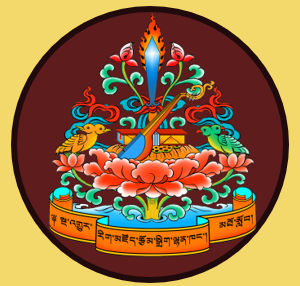The Jarung Khashor stupa is a famous Buddhist stupa located about 11 km from the centre of Kathmandu in its north-eastern outskirts. It is a sacred stupa related to the profound deeds of Lord Avalokiteshvara and Khen-Lop-Choe Sum 1 of Tibet. The narrative goes like this: Many eons ago, Lord Avalokiteshvara promised in front of Buddha Amitabha to liberate all the sentient beings from samsara before he attained buddhahood. So, with much determination he began to liberate them.

But one day, from Mount Potala (the pure land of Avalokiteshvara), when he looked down thinking he had liberated all the sentient beings, he could see countless beings still suffering in samsara. He felt very sad and shed tears. He flicked his tears with his ring finger in the sky and prayed that those tears would help beings to attain buddhahood. By the power of his aspiration, two goddesses named Gangchungma and Gangama were born as the daughters of Shakra (the king of trayastriṃśat heaven). One day Gangchungma stole a flower, breaking a rule of the god’s realm. As a consequence of stealing she was born as a poultry keeper named Samvari to a poor family in Nepal. She had four sons from different fathers.
She was kind-hearted and had spiritual faith and devotion to the Buddhadharma. She aspired to build a great stupa as an offering, using her hard-earned savings. So, she approached the local king for permission to do so and it was granted on the condition that she would only use a piece of land the size of an ox’s hide.
She agreed; however, she cut the hide into thin strips and strung them together. She then circled a large piece of land with the string and claimed it. Some rich people got jealous and asked the king to stop the construction. The king replied, “Since I have given my permission, it cannot be taken back.”
Thus, the stupa was named Jarung Khashor (jarung means “it can be done”; kha, “words” and shor, “given”).
Unfortunately, during the process of the construction, she passed away. So, her four sons had to complete her remaining work with the help of an ox. They took seven years to complete the stupa. The stupa contained medicinal and precious herbs, precious stones, relics of the third buddha, Kasyapa,2 and so on as sacred objects for blessing the stupa.
After completing the stupa, the four sons made aspirations during the consecration ceremony: The eldest son aspired to be the Dharma king in the Land of Snow (Tibet) where there was no Dharma; the second eldest son aspired to be a great scholar; the third eldest aspired to be a powerful yogi; and the youngest son aspired to be a king’s minister who would unite the three of them—the king, the scholar, and the yogi—in Tibet.
While the four of them were making aspirations, the ox got angry that the four did not make an aspiration for him. So, out of rage he made an aspiration to be the destroyer of the Dharma. At the same time a crow was listening to their aspirations, and when it heard the negative aspiration of the ox, the crow made an aspiration to be born as the slayer of the Dharma destroyer.
According to their aspirations, in the next life the eldest son was born as the Dharma king Trisong Deutsen, the second eldest son became the great scholar Shantarakshita, the third son became the great yogi Padmasambhava, and the youngest son became the minister Ba Salnang. Through its negative aspiration, the ox was reborn as the Dharma destroyer, Langdarma, who later became a king and destroyed the Dharma in Tibet. The crow was reborn as Lhalung Palgyi Dorje who later killed Langdarma.
It is believed that thousands of buddhas and bodhisattvas descended from heaven in the form of light rays and entered the stupa during the consecration. Thus, this stupa is also called “the stupa blessed by a thousand buddhas”.
Loponma Karma Yangku
PMTC



